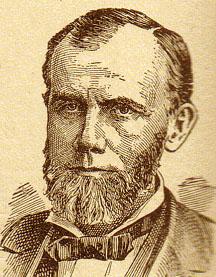- Home
- Archival Material
- College History Projects
- Subject-Based Digital Projects
Nathaniel Thomas Lupton (1830-1893)

Nathaniel T. Lupton was born to Nathaniel and Elizabeth Hodgson Lupton on December 30, 1830 near Winchester in Frederick County, Virginia. He received preparation for undergraduate studies at Newark Academy in Delaware. Lupton then entered the Dickinson College in Carlisle, Pennsylvania with the class of 1849 as a junior in 1846, planning to study the law. While at the College, he was elected to the Belles Lettres Society.
Lupton graduated with his class fully intending to become a lawyer, but succumbed soon after to a flattering job offer as professor of chemistry at Aberdeen Female College, a Methodist institution in Mississippi. A year later, in the fall of 1852, he was named to the same post at another Methodist female college in Petersburg, Virginia. In 1854, at the age of twenty-four, Lupton became president of the Petersburg College and served in that post for two years. He next moved on to a position as professor of chemistry at Randolph-Macon College in 1856, then took a professorship at the newly opening Southern University in Greensboro, Alabama. Since Lupton was not to begin teaching at Southern until 1859, he was able to travel to Europe to equip the science laboratories of the new institution. There he took the opportunity to spend the year 1858 studying under Robert Bunsen at the University of Heidelberg. Lupton left Southern University for a time during the Civil War in order to help run the Confederate Nitre and Mining Bureau so vital to the continued supply of ammunition to southern fighting forces. His works at Selma, Alabama were providing 500 pounds of powder a day in 1864. When the Union Army overran the factories in 1865, they destroyed 6,000 rounds of artillery ordnance, 70,000 rounds of small arms ammunition, and 14,000 pounds of powder. Lupton returned to Southern and remained there until 1871, when he left to become the fifth president of the newly re-organizing University of Alabama.
The University of Alabama had suffered grievously during the war; the Tuscaloosa campus had been almost completely destroyed. Lupton struggled manfully with the institution's financial and personnel problems. When he left the university for a post at the new Vanderbilt University in 1874, it was with the appreciation of both faculty and trustees. Lupton spent eleven years in Tennessee. There he served as chemistry professor and head of the School of Pharmacy, again traveling to Europe to stock Vanderbilt's laboratories with equipment. His final move was to the Alabama Polytechnic Institute, modern day Auburn University, the founding of which had been a source of heated debate in his days at the University of Alabama twelve years before. Lupton combined that teaching position with the post of State Chemist of Alabama. He was at Auburn from 1885 until his death.
Lupton involved himself with several western mining ventures after the Civil War. He spent many of his summers traveling in remote parts of Mexico, assaying mines, fishing, and collecting specimens of native mountain trout. He also interested himself in Native American relics and burial mounds.
In September 1854, Lupton married Ella Virginia Allemong of Newtown, Virginia. The couple had three children, including Kate, who was the first woman to graduate from Vanderbilt University. A devout Methodist, Lupton spent most of his career in Methodist influenced institutions from Dickinson onwards. Lupton was also a Democrat in politics. Nathaniel Thomas Lupton died at Auburn on June 11, 1893. He was sixty-two years old.
Date of Post:
2005
College Relationship:
Alumnus/Alumna Class Year: